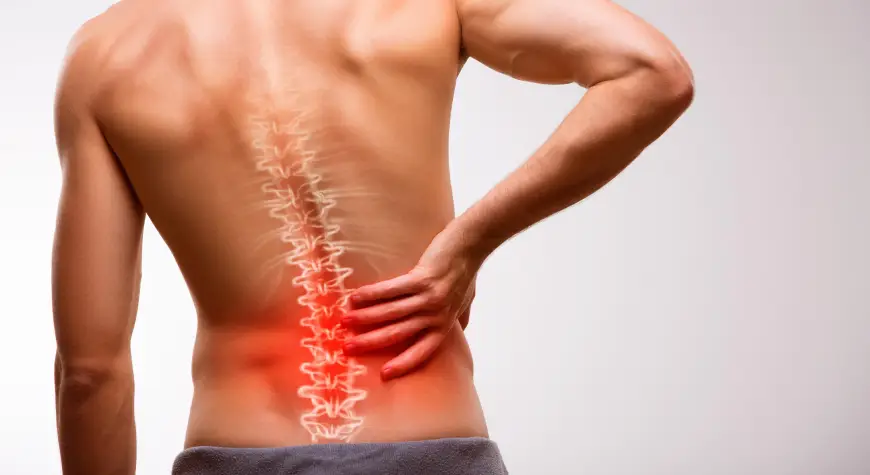What is Low back pain?

Low back pain is a discomfort or ache in the lower part of your back. It can feel like a dull, constant pain or a sudden, sharp sensation. Most people experience it at some point in their lives, and it can range from mild to severe, sometimes affecting your ability to move or perform daily activities.
Symptoms of Low Back Pain can vary but commonly include:
- A persistent, dull ache in the lower back.
- Sudden and intense pain that may radiate to other parts of the body.
- Difficulty moving or standing up straight due to stiffness in the lower back.
- Tight, painful muscle contractions in the lower back.
- Increased pain when bending, lifting, standing, or walking.
- Reduced ability to move the lower back.
- Pain that spreads to the buttocks, thighs, or legs (sciatica).
- A feeling of numbness or tingling in the lower back or legs.
Seek immediate medical care for low back pain if you experience any of the following, as these could be signs of a serious condition:
- Severe pain
- Persistent Numbness or tingling
- Weakness in the legs or difficulty walking.
- Loss of bladder or bowel control.
- Pain following an accident, fall, or injury
- Unexplained weight loss accompanied by back pain.
- Fever with back pain
- History of cancer: Back pain in someone with a history of cancer.
If you experience any of these symptoms, it’s crucial to get medical help immediately to rule out serious underlying conditions and receive appropriate treatment.
Causes of Low Back Pain
- Overstretching or tearing of muscles or ligaments from lifting something heavy, twisting awkwardly, or sudden movements.
- Sitting or standing with poor posture for long periods, which puts extra stress on the lower back.
- Herniated Disc: The soft, jelly-like center of a spinal disc pushes out through a tear, pressing on nerves and causing pain.
- Falls, accidents, or sports injuries can cause damage to the back, resulting in pain.
- Age-related degeneration can also lead to pain.
- Pain that radiates from the lower back down the leg, caused by pressure on the sciatic nerve.
- Skeletal Irregularities like a curved spine that put a strain on the lower back.
- Osteoporosis: Weak and brittle bones that can fracture easily, sometimes leading to back pain.
- Stress and Tension: Emotional stress can cause muscle tension and pain in the lower back.
- Everyday activities and habits like poor lifting techniques, lack of exercise, and being overweight can also contribute to low back pain.
- Infections or Tumors:Although rare, infections or tumors in the spine can cause low back pain.
Diagnosis for low back pain typically involves:
The doctor will ask about your symptoms, any recent injuries, your activity levels, and any other relevant medical conditions. The doctor will check your back and assess your range of motion, flexibility, and reflexes. They may also look for signs of nerve damage, such as numbness or weakness.
If more information is needed your doctor may ask you to get a few imaging (X-ray, MRI, or CT scan), nerve studies, or some blood tests done.
Here at Synchrony Healthcare we focus on the correct and accurate diagnosis of condition by our expert physiotherapist.
Low back pain can be managed by
It is essential to work with a healthcare provider to determine the most appropriate treatment plan based on individual needs and the specific cause of the low back pain.
- Rest and Activity Modification: Limit activities that worsen the pain.
- Medications:Over-the-counter pain relievers, anti-inflammatory drugs, muscle relaxants, and sometimes antidepressants.
- Heat and Cold Therapy: Applying ice packs to reduce inflammation and numb the pain. Using heat packs or warm baths to relax muscles and improve blood flow.
- Physical Therapy:Exercises aimed at strengthening back muscles and improving posture.
- Lifestyle Modifications:Weight loss, proper lifting techniques, and regular physical activity.
- Injections:Cortisone injections to reduce inflammation and alleviate pain.
- Surgery:Considered in severe cases where other treatments have failed, such as for herniated discs or spinal stenosis.
How do we treat low back pain at Synchrony?
Synchrony offers a holistic and effective approach to managing low back pain. Based on the assessment, a personalized treatment plan is developed.
By combining education, exercise, and manual therapy, physiotherapists help patients alleviate pain, improve function, and prevent future episodes.
- Education and Advice:
- Educating the patient on maintaining proper posture during various activities.
- Advising on how to modify daily activities to reduce strain on the back.
- Teaching techniques to manage pain, such as heat or cold therapy.
- Exercise Therapy:
- Stretching Exercises:Improving flexibility and relieving muscle tightness.
- Strengthening Exercises:Focusing on the core muscles (abdominals, back muscles, and pelvis) to provide better support for the spine.
- Aerobic Conditioning:Low-impact aerobic exercises like walking, swimming, or cycling to improve overall fitness and reduce back pain.
- Manual Therapy:
- Manual Tissue Release:Reducing muscle tension and improving blood circulation.
- Mobilization and Manipulation:Improving the movement of the spine and relieving pain.
If you’re experiencing low back pain, consulting with our expert physiotherapist can provide you with a tailored treatment plan to help you regain mobility and improve your quality of life.
Frequently asked questions
- Why low back pain occurs?
It can result from a strain (injury) to muscles or tendons in the back. Other causes include arthritis, structural problems, and disk injuries.
- What makes my back pain worse?
A desk job may also play a role, especially if you have poor posture or sit all day in an uncomfortable chair.
- Can stress cause Low back pain?
If you chronically have poor sleep, depression, or anxiety, back pain can be more frequent and more severe.
- Why low back pain is common
they bear the majority of your body’s weight and are responsible for most of your bending and lifting movements.
- Will exercise help relieve the back pain or will it aggravate my back pain?
exercise often helps to ease back pain and prevent further discomfort
- Will low back pain go away?
If your back pain doesn’t go away after 4 weeks or if you have long-term pain that lasts beyond 12 weeks and keeps you from carrying on with your daily activities, see your doctor. They can help pinpoint the cause of your pain and may suggest new therapies.
- When low back pain is serious?
Lasts longer than a few weeks. Is severe and doesn’t improve with rest. Spreads down one or both legs, especially if the pain goes below the knee.
- How should I sleep with low back pain?
The best sleeping position for lower back pain is on your side with a partial bend in the knees. Keeping the knees bent helps balance the body and reduces pressure on the lumbar spine. Many people find it helpful to put a small pillow between their knees to make this position more comfortable.
- Is walking good for low back pain?
Walking may be a natural and enjoyable way to alleviate low back pain. By gradually improving cardiovascular fitness, patients will find that they can engage in additional physical activities to further strengthen and support their back. But if walking is aggravating your symptoms, you should avoid it.
- Low back pain can be prevented
Do muscle-strengthening and stretching exercises at least 2 days a week. Stand and sit up straight. Avoid heavy lifting. If you do lift something heavy, bend your knees and keep your back straight.
